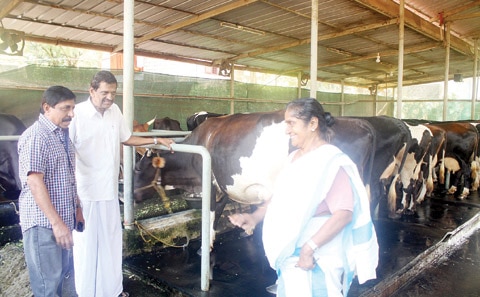Friday, January 30, 2015
Monday, January 26, 2015
Friday, January 23, 2015
Authority for Issuing Non - Creamy Layer Certificate- Amended- Orders Issued
* G.O(P) NO.3/2015/BCDD Dated, 23.01.2015* *Backward Communities Development Department - Scheme for excluding the creamy layer from the Socially and Educationally Backward Classes for admission to Professional Degree Courses - Authority for Issuing Non - Creamy Layer Certificate- Amended- Orders Issued
Click to view
Departmental Test January 2015 Time Table
Departmental Test January 2015 Time Table
The Departmental Tests notified in extra ordinary Kerala Gazette No. 2711 dated 11.11.2014 will be held from 29.01.2015 to 19.02.2015. The tests will be objective type (OMR valuation) except the tests for the II nd class Language Test in Malayalam/Tamil/Kannada, Minority Language Test in Kannada and Tamil.
|
Wednesday, January 21, 2015
സൂചന പണിമുടക്കിന് ഡൈസ് നോണ് (DIES-NON) ബാധകമാക്കി സര്ക്കാര് ഉത്തരവ്
ഒരു വിഭാഗം സംസ്ഥാന സര്ക്കാര് ജീവനക്കാരും അദ്ധ്യാപകരും 22-01-15-ല് നടത്താന് നിശ്ചയിച്ചിട്ടുള്ള സൂചന പണിമുടക്കിന് ഡൈസ് നോണ് (DIES-NON) ബാധകമാക്കി സര്ക്കാര് ഉത്തരവ്
Monday, January 19, 2015
Wednesday, January 14, 2015
For him, the wild was no alien turf
As close as it gets:C. Gopakumar tries to rescue a leopard which got caught in a trap laid by residents of Avolikkuzhy, near Konni,in February 2013.
Death of veterinarian exposes need to provide support to those on high-risk jobs
The trampling to death of veterinary officer C. Gopakumar by an elephant in musth at Vaipur, near Mallappally, on Sunday exposes the issues faced by personnel undertaking work as risky as tranquilising animals.
Dr. Gopakumar, one of the seven licensed elephant squad members of the Animal Husbandry Department in the State, was known for commendable work in the rescue and care of animals, especially elephants. As a veterinary surgeon with a passion for pachyderms, he played a sterling role in ensuring animal welfare, especially that of animals, in the central and southern parts of the State.
Individuals and organisations such as the Travancore Devaswom Board (TDB) had banked on him heavily with regard to safe tranquilisation of elephants in musth.
The initiative of Dr. Gopakumar in caring for elephants inspired a generation of elephant lovers, conservationists, and veterinarians. He had shown immense courage to prevent elephant casualties at temples. He had tranquilised not less than 250 elephants in the past 15 years.
He had saved many leopards, wild elephants, and bisons which had strayed into human habitations.
Once, a leopard rescued from a trap laid by people on the forest fringes of Avolikkuzhy, near Konni, in February 2013 attacked the veterinarian when it was being released in the wild.
George Varghese, district president of the Kerala Government Veterinary Officers Association (KGVOA), says Dr. Gopakumar’s death should be an eye-opener. The government has miserably failed to ensure adequate security cover to veterinary officers on tranquilisation duty, he says. The government should address issues such as shortage of staff and equipment. Adequate police security, especially for crowd control, should be provided. The government is yet to sanction even a monthly risk allowance of Rs.270 as recommended by the Pay Commission in 2011, he says.
Death of veterinarian in the line of duty exposes the urgent need to provide support to those on high-risk jobs.
Sunday, January 11, 2015
Saturday, January 10, 2015
Tuesday, January 6, 2015
മന്ത്രി പി.ജെ.ജോസഫിന്റെ കൃഷിയിടവും തൊഴുത്തും കാണാന് നടന് ശ്രീനിവാസന്
മന്ത്രി പി.ജെ.ജോസഫിന്റെ കൃഷിയിടവും തൊഴുത്തും കാണാന് നടന് ശ്രീനിവാസന്

തൊടുപുഴ: കൃഷിക്കാരനായ മന്ത്രി പി.ജെ.ജോസഫിന്റെ തൊഴുത്തിലേക്കു ചെന്ന നടന് ശ്രീനിവാസന് ആദ്യം ഞെട്ടി. പിന്നെ പൊട്ടിച്ചിരിച്ചു. തൊഴുത്തില് സ്ഥാപിച്ചിരിക്കുന്ന ടേപ്പ് െറേക്കാഡില്നിന്ന് ഉയര്ന്ന പാട്ടാണ് ശ്രീനിയെ ചിരിപ്പിച്ചത്. 'അനുവാദമില്ലാതെ അകത്തു വന്നു, നെഞ്ചില് അടച്ചിട്ട മണിവാതില് നീ തുറന്നു' എന്ന പാട്ടായിരുന്നു തൊഴുത്തില് മുഴങ്ങിയത്.
തൊടുപുഴ കാര്ഷികമേളയ്ക്ക് എത്തിയ ശ്രീനി മന്ത്രിയുടെ പുറപ്പുഴയിലെവസതിയിലെത്തിയതായിരുന്നു. ചെങ്കദളി കുല നല്കി മന്ത്രി കുടുംബസമേതം താരത്തെ സ്വീകരിച്ചു. ജോസഫ് എന്ന കര്ഷകനെക്കുറിച്ച് കേട്ടറിവ് ഉണ്ടായിരുെന്നങ്കിലും വീട്ടില് എത്തി കാണണമെന്ന മോഹം കുേറ നാളുകളായി മനസ്സില് കൊണ്ടുനടക്കുകയായിരുെന്നന്ന് ശ്രീനിവാസന് പറഞ്ഞു.
ജൈവകൃഷിയെക്കുറിച്ച് സംസാരിച്ചു തുടങ്ങിയപ്പോള് ജോസഫിനും ശ്രീനിവാസനും നൂറു നാവ്. പുരയിടത്തിലെ വാഴകൃഷിയെക്കുറിച്ച് ജോസഫ് സംസാരിച്ചു. 30-ല്പ്പരം ഇനം വാഴകള് ഇവിടെ കൃഷി ചെയ്യുന്നുണ്ട്. പടത്തിപ്പഴവും ചായയും കഴിച്ച ശ്രീനിവാസന് താന് പാട്ടത്തിനെടുത്ത 35 ഏക്കറില് നെല്കൃഷി ചെയ്യുന്ന കാര്യം പറഞ്ഞു. തൊഴിലുറപ്പുജോലി കാര്യക്ഷമമാക്കേണ്ടതിനെക്കുറിച്ചും ഇരുവരും സംസാരിച്ചു. ക്ഷീരകര്ഷകരെയും തൊഴിലുറപ്പിന്റെ പരിധിയില് കൊണ്ടുവരുന്ന കാര്യം പരിഗണനയിലാണെന്ന് ജോസഫ് പറഞ്ഞു. യന്ത്രങ്ങളുള്ളതുകൊണ്ടാണ് പാടത്ത് പണിനടക്കുന്നതെന്ന് ശ്രീനിവാസന്.കേന്ദ്രമന്ത്രിയായിരുന്ന നിതീഷ്കുമാര് തൊടുപുഴയിലെ കാര്ഷികമേളയില് വന്ന കാര്യവും പുറപ്പുഴയിലെ പുരയിടം സന്ദര്ശിച്ച വിശേഷങ്ങളും ജോസഫ് പങ്കുവച്ചു. ശ്രീനിക്ക് പശുക്കളുണ്ടോ എന്നായിരുന്നു മന്ത്രിയുടെ ഭാര്യ ഡോ. ശാന്തയുടെ ചോദ്യം. കാസര്കോട് കുള്ളന് എന്ന ഇനം പശുവാണ് തനിക്കുള്ളതെന്ന് മറുപടി. ഇതിനിടെ ജോസഫിന്റെ മകന് അപു എത്തി. സ്വിറ്റ്സര്ലന്ഡില് എന്ജിനിയറായിരുന്ന അപു ജോലി രാജിവച്ച് കൃഷിയിലേക്കിറങ്ങിയിരിക്കുകയാണ്. ഒരു മണിക്കൂറോളം ജോസഫിന്റെ വസതിയില് ചെലവഴിച്ച ശ്രീനിവാസന് കുടുംബവിശേഷങ്ങളും സിനിമാവിശേഷങ്ങളും പങ്കുവച്ചാണ് മടങ്ങിയത്.
Subscribe to:
Posts (Atom)



